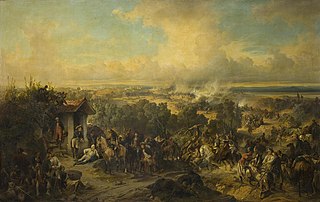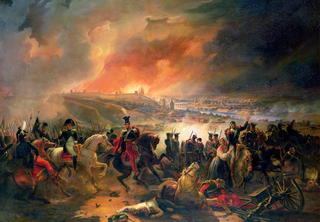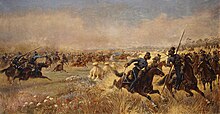
Prince Pyotr Ivanovich Bagration was a Russian general and prince of Georgian origin, prominent during the French Revolutionary and Napoleonic Wars.

The Battle of Borodino took place near the village of Borodino on 7 September [O.S. 26 August] 1812 during Napoleon's invasion of Russia. The Grande Armée won the battle against the Imperial Russian Army, but failed to gain a decisive victory and suffered tremendous losses. Napoleon fought against General Mikhail Kutuzov, whom the Emperor Alexander I of Russia had appointed to replace Barclay de Tolly on 29 August [O.S. 17 August] 1812 after the Battle of Smolensk. After the Battle of Borodino, Napoleon remained on the battlefield with his army; the Imperial Russian forces retreated in an orderly fashion southwards. Because the Imperial Russian army had weakened the Grande Armée, they allowed the French occupation of Moscow, using scorched earth tactics on their own population to trap Napoleon and his men with their own largest city. The failure of the Grande Armée to completely destroy the Imperial Russian army, and in particular Napoleon's reluctance to deploy his Imperial Guard due to Napoleon's wishes to negotiate with Alexander to make him join against the British, has been widely criticised by historians as a large blunder, as it allowed the Imperial Russian army to continue its retreat into territory increasingly hostile to the French.

The Battle of (the) Trebbia was fought near the rivers of Tidone, Trebbia, and Nure in northern Italy between the joint Russian and Habsburg army under Alexander Suvorov and the Republican French army of Étienne-Jacques-Joseph-Alexandre Macdonald. Though French forces were moderately more numerous, the Austro-Russians severely defeated the French, sustaining about 5,500 casualties while inflicting losses of 16,500 on their enemies. The War of the Second Coalition engagement occurred west of Piacenza, a city located 70 kilometres (43 mi) southeast of Milan.

The Battle of Smolensk was the first major battle of the French invasion of Russia. It took place on 16–18 August 1812 and involved about 45,000 men of the Grande Armée under Emperor Napoleon I against about 30,000 Russian troops under General Barclay de Tolly. Napoleon occupied Smolensk by driving out Prince Pyotr Bagration's Second Army. The French artillery bombardment burned the city to the ground. Of 2,250 buildings, 84% were destroyed with only 350 surviving intact. Of the city's 15,000 inhabitants, about 1,000 were left at the end of the battle inside the smoking ruins. With over 15,000 casualties, it was one of the bloodiest battles of the invasion.

The Battle of Heilsberg took place on 10 June 1807 off the town of Heilsberg, during the Napoleonic Wars.

The Battle of Cassano was fought in 1799 from 27 to 28 April near Cassano d'Adda, which about 28 km (17 mi) ENE of Milan. The clash is part of the battle of the Adda River or the so-called forcing of the Adda, which on the first day of 26 April resulted in a minor victory for the Russians under the Count Suvorov over Barthélemy Schérer's French forces at Lecco. Then, on the second day, Suvorov's Austrians and Cossacks prevailed over Jean Moreau's army, who replaced Schérer as supreme commander, and trapped his isolated division on the third. The action took place during the War of the Second Coalition, as part of the larger conflict known as the French Revolutionary Wars.

Count Matvei or Matvey Ivanovich Platov was a Russian general who commanded the Don Cossacks in the Napoleonic wars and founded Novocherkassk as the new capital of the Don Host Province.

The Battle of Krasnoi unfolded from 15 to 18 November 1812 marking a critical episode in Napoleon's arduous retreat from Moscow. Over the course of six skirmishes the Russian forces under field marshal Kutuzov inflicted significant blows upon the remnants of the Grande Armée, already severely weakened by attrition warfare. These confrontations, though not escalated into full-scale battles, led to substantial losses for the French due to their depleted weapons and horses.

The Battle of Vyazma, occurred at the beginning of Napoleon's retreat from Moscow. In this encounter a Russian force commanded by General Miloradovich inflicted heavy losses on the rear guard of the Grande Armée. Although the French thwarted Miloradovich's goal of encircling and destroying the corps of Marshal Davout, they withdrew in a partial state of disorder due to ongoing Russian harassment and heavy artillery bombardments. The French reversal at Vyazma, although indecisive, was significant due to its damaging impact on several corps of Napoleon's retreating army.
The Imperial Russian Army in June 1812 consisted of three main armies and other military formations. The Commander in Chief of the Army was Emperor Alexander I.

The French invasion of Russia, also known as the Russian campaign, the Second Polish War, and in Russia as the Patriotic War of 1812, was initiated by Napoleon with the aim of compelling the Russian Empire to comply with the continental blockade of the United Kingdom. Widely studied, Napoleon's incursion into Russia stands as a focal point in military history, recognized as among the most devastating military endeavors globally. In a span of fewer than six months, the campaign exacted a staggering toll, claiming the lives of nearly a million soldiers and civilians.

This is the order of battle of the French invasion of Russia.

The battle of Vitebsk, sometimes spelled Witepsk, was a military engagement that took place on 26 and 27 July 1812 during the French invasion of Russia. The battle put a French force, under the command of Emperor Napoleon I, in combat with Russian rearguard forces under General Petr Konovnitsyn and Peter von der Pahlen and ended with the Russian forces making a strategic retreat from the battlefield.

In the Battle of Guttstadt-Deppen on 5 and 6 June 1807, troops of the Russian Empire led by General Levin August, Count von Bennigsen attacked the First French Empire corps of Marshal Michel Ney. The Russians pressed back their opponents in such a way that saw Ney fight a brilliant rearguard action with his heavily outnumbered forces. During the 6th, Ney successfully disengaged his troops and pulled back to the west side of the Pasłęka (Passarge) River. The action occurred during the War of the Fourth Coalition, part of the Napoleonic Wars. Dobre Miasto (Guttstadt) is on Route 51 about 20 kilometers (12 mi) southwest of Lidzbark Warmiński (Heilsberg) and 24 kilometers (15 mi) north of Olsztyn (Allenstein). The fighting occurred along Route 580 which runs southwest from Guttstadt to Kalisty (Deppen) on the Pasłęka.
The IV Cavalry Corps of the Grande Armée was a French military unit that existed during the Napoleonic Wars. The corps was created in 1812 and rebuilt in 1813 and 1815. Emperor Napoleon I first organized the corps for the invasion of Russia. Under General Victor de Fay de La Tour-Maubourg, the corps fought at Borodino. During the War of the Sixth Coalition in 1813, General François Étienne de Kellermann commanded the all-Polish corps at Leipzig.

Charles Claude Jacquinot commanded a French cavalry division at the Battle of Waterloo in 1815. He joined a volunteer battalion in 1791 and transferred to a light cavalry regiment as a junior officer in 1793. He earned promotion to squadron commander and was acting commander of his regiment at Hohenlinden in 1800. After serving in a staff position at Austerlitz in 1805, he led a light cavalry regiment at Jena in 1806. Promoted to general of brigade he led his horsemen at Abensberg, Raab and Wagram in 1809. During the French invasion of Russia he fought at Ostrovno, Smolensk and Borodino in 1812. During the 1813 German Campaign he led a cavalry brigade at Dennewitz and Leipzig. After being appointed general of division he fought at Second Bar-sur-Aube and Saint-Dizier in 1814. During the Hundred Days he rallied to Napoleon and led a light cavalry division in the Waterloo campaign. After 15 years of inactivity, he was restored to favor in the 1830s. Thereafter he held a number of commands and was appointed to the Chamber of Peers. His surname is one of the names inscribed under the Arc de Triomphe, on Column 20.
Kutuzov is a 1943 Soviet drama film directed by Vladimir Petrov.

French Emperor Napoléon Bonaparte's Grande Armée occupied Moscow from 14 September to 19 October 1812 during the Napoleonic Wars. It marked the summit of the French invasion of Russia. During the occupation, which lasted 36 days, the city was devastated by fire and looted by both Russian peasants and the French.

The Battle of Inkovo took place on 8 August 1812, between the Cossack corps of General Platov and the 2nd Light Cavalry Division of General Sebastiani and ended as a minor Russian victory.

The Battle of Grodno was one of the first battles that took place on June 27–28 at the initial stage of the Patriotic War of 1812 between the vanguard of the right wing of Napoleon's Grand Army and the rearguard of the Russian 2nd Western Army.


















